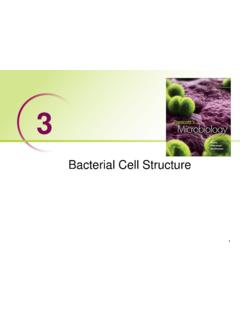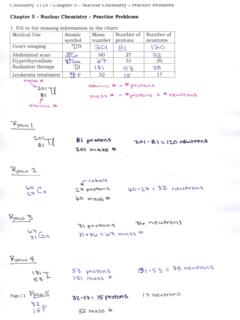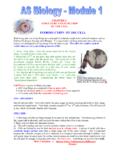Transcription of Eukaryotic Cell Structure - Bellarmine University
1 Eukaryotic Cell Structure 1 5 A typical Eukaryotic cell and contrast Eukaryotic , bacterial, and archaeal cells in terms of their use of membranes, size, morphological diversity, and organelles. 2 Eukaryotic Microorganisms Prominent members of ecosystems Useful as model systems and industry Some are major human pathogens Two groups of eukaryotes commonly possess microbial members protists fungi 3 4 Common Features of Eukaryotic Cells Membrane-delimited nuclei Membrane-bound organelles that perform specific functions Intracytoplasmic membrane complex serves as transport system More structurally complex and generally larger than bacterial or archaeal cells 5 6 7 Eukaryotic cell envelopes the types of Eukaryotic microbes that have cell walls
2 And distinguish them from plant cell walls. and contrast the cell envelopes of members of Bacteria, Archaea, and Eukarya in terms of their component layers, molecular make-up, and function. 8 Eukaryotic Cell Envelopes Consists of the plasma membrane and all coverings external to it Plasma membrane is a lipid bilayer major membrane lipids include phosphoglycerides, sphingolipids, and cholesterol, all of which contribute to strength of membrane microdomains participate in variety of cellular processes 9 10 Eukaryotic Cell Envelopes - 2 Unlike the peptidoglycan in the cell wall of Bacteria and Archaea, many eukaryotes lack or have a chemically distinct cell wall Cell walls of photosynthetic algae have cellulose, pectin.
3 And silica Cell walls of fungi consist of cellulose, chitin, or glucan 11 Cytoplasm of eukaryotes the functions of the cytoplasm. the three filaments that make up the cytoskeleton of Eukaryotic cells and describe their functions. 12 The Cytoplasm of Eukaryotes Consists of liquid, the cytosol, and many organelles Cytoskeleton vast network of interconnected filaments within the cytoplasmic matrix filaments that form the cytoskeleton: microfilaments (actin), microtubules, intermediate filaments, and motor proteins plays role in both cell shape and cell movement 13 14 Microfilaments Small protein filaments, 4 to 7 nm in diameter Scattered within cytoplasmic matrix or organized into networks and parallel arrays Composed of actin protein Involved in cell motion and shape changes 15 Intermediate Filaments Heterogeneous elements of the cytoskeleton.
4 ~10 nm in diameter Keratin and vimentin classes Role in cell is unclear play structural role some shown to form nuclear lamina others help link cells together to form tissues 16 Microtubules Shaped like thin cylinders ~25 nm in diameter of - and -tubulin Help maintain cell shape Involved with microfilaments in cell movements Participate in intracellular transport processes 17 Organelles of the secretory and endocytic pathways the two types of endoplasmic reticulum in terms of Structure and function. the pathway of molecules through the secretory pathway, noting the structures involved and their role in the process.
5 The endocytic pathways observed in mammalian cells, noting the structures involved and their role in the process, and noting those pathways that have been observed in Eukaryotic microbes. 18 Secretory Endocytic Pathway Intricate complex of membranous organelles and vesicles that move materials into the cell from outside, from inside to outside, and within the cell Endoplasmic reticulum (ER) Golgi apparatus Lysosomes 19 Endoplasmic Reticulum (ER) Irregular network of branching and fusing membranous tubules and flattened sacs (cisternae s., cisterna) Rough ER ribosomes attached synthesis of secreted proteins by ER-associated ribosomes Smooth ER devoid of ribosomes synthesis of lipids by ER-associated enzymes 20 Functions of ER Transports proteins, lipids, and other materials within cell Major site of cell membrane synthesis 21 The Golgi Apparatus Membranous organelle made of cisternae stacked on each other Cis and trans faces Dictyosomes=stacks of cisternae Involved in modification, packaging.
6 And secretion of materials 22 Lysosomes Membrane-bound vesicles found in most eukaryotes Involved in intracellular digestion Contain hydrolases, enzymes which hydrolyze molecules and function best under slightly acidic conditions Maintain an acidic environment by pumping protons into their interior 23 24 The Secretory Pathway Used to move materials to various sites within the cell, as well as to either the plasma membrane or cell exterior Proteins destined for the cell membrane, endosomes, and lysosomes or secretion are synthesized by ribosomes on rough endoplasmic reticulum (RER) Targeted to RER lumen and are released in small budding vesicles from RER 25 Secretory Pathway - 2 Released in small vesicles cis face of Golgi apparatus trans face of Golgi apparatus modification of proteins occurs in Golgi.
7 Targets protein for final destination Transport vesicles released from trans face of Golgi 26 The Secretory Pathway - 3 After release some vesicles deliver their contents to endosomes and lysosomes Two types of vesicles deliver proteins to cell membrane constitutive delivery to membrane secretory vesicles in multicellular eukaryotes store proteins until signal to release 27 The Secretory Pathway - 4 Quality assurance mechanism unfolded or misfolded proteins are secreted into cytosol, targeted for destruction by ubiquitin polypeptides proteasomes destroy targeted proteins 28 The Endocytic Pathway Endocytosis used by all Eukaryotic cells used to bring materials into the cell solutes or particles taken up and enclosed in vesicles pinched from plasma membrane in most cases materials are then delivered to lysosome and destroyed 29 Types of Endocytosis Phagocytosis: use of cell surface protrusions to surround and engulf particles Clathrin-dependent.
8 Clathrin protein-coated pits have external receptors that specifically bind macromolecules Caveolae-dependent endocytosis: may play role in signal transduction, transport of small as well as macromolecules 30 Endocytosis Clathrin-coated vesicles and some caveolin-coated vesicles deliver contents to endosomes (organelles with hydrolytic enzymes) Early endosomes develop into late endosomes which fuse with lysosomes Caveosomes fuse with early endosomes 31 Autophagy Delivery of materials to be digested by route that does not involve endocytosis Macroautophagy involves digestion and recycling of cytoplasmic components Double membrane surrounds cell component forming an autophagosome Autophagosome fuses with a lysosome 32 Once Lysosome Is Digestion occurs without release of lysosome enzymes into cytoplasmic matrix As contents are digested.
9 Products leave lysosome and can be used as nutrients Resulting lysosome called a residual body which can release contents to cell exterior by process called lysosome secretion 33 Organelles involved in genetic control of the cell the Structure of the nucleus, chromosomes, nucleolus, and Eukaryotic ribosomes. and contrast the chromosomes and ribosomes of bacterial, archaeal, and Eukaryotic cells. 34 35 Organelles Involved in Genetic Control of the Cell Nucleus Ribosomes The Nucleus - 1 Membrane-bound spherical Structure that houses genetic material of Eukaryotic cell Contains dense fibrous material called chromatin complex of DNA, histones, and other proteins five types of histones form nucleosomes H1, H2A, H2B, H3.
10 And H4 chromatin condenses into chromosomes during division 36 The Nucleus - 2 nuclear envelope double membrane Structure that delimits nucleus continuous with ER penetrated by nuclear pores associated proteins make up the nuclear pore complex pores allow materials to be transported into or out of nucleus 37 The Nucleolus 1 nucleolus/nucleus Organelle but not membrane enclosed Important in ribosome synthesis directs synthesis and processing of rRNA directs assembly of rRNA to form partial ribosomal subunits ribosomes mature in cytoplasm 38 Eukaryotic Ribosomes - 1 Larger (more mass) than the 70S bacterial and archaeal ribosomes 80S in size 60S + 40S subunits May be attached to ER or free in cytoplasmic matrix 60S is bound subunit to ER 39 Eukaryotic Ribosomes - 2 Proteins made on ribosomes of RER are often secreted or inserted into ER membrane as integral membrane proteins Free ribosomes synthesize nonsecretory and nonmembrane proteins some proteins are inserted into organelles 40 Organelles involved in energy conservation a mitochondrion and identify its component parts.






